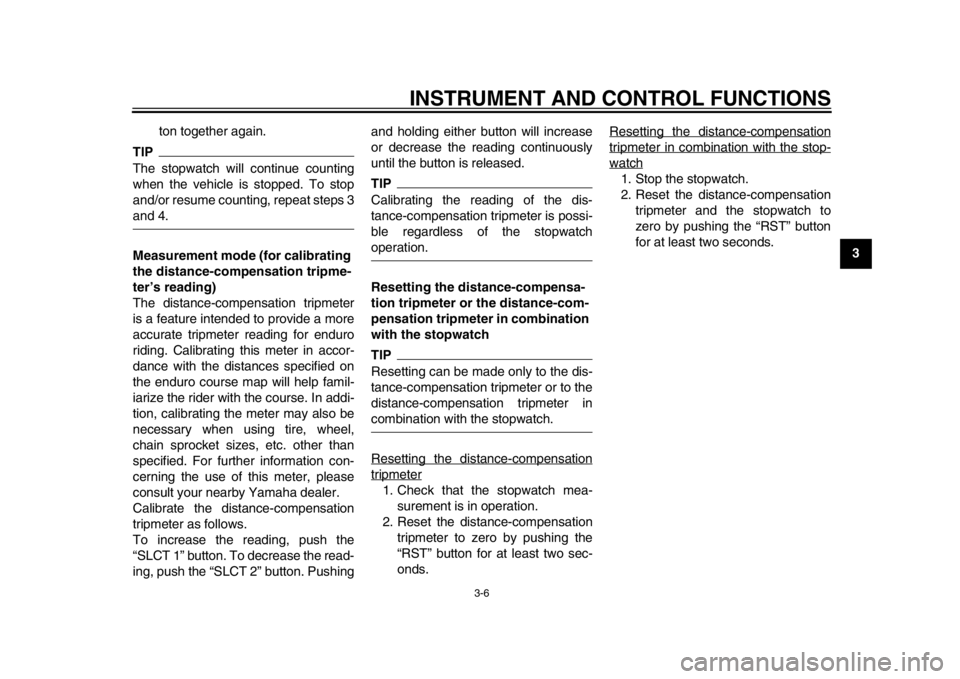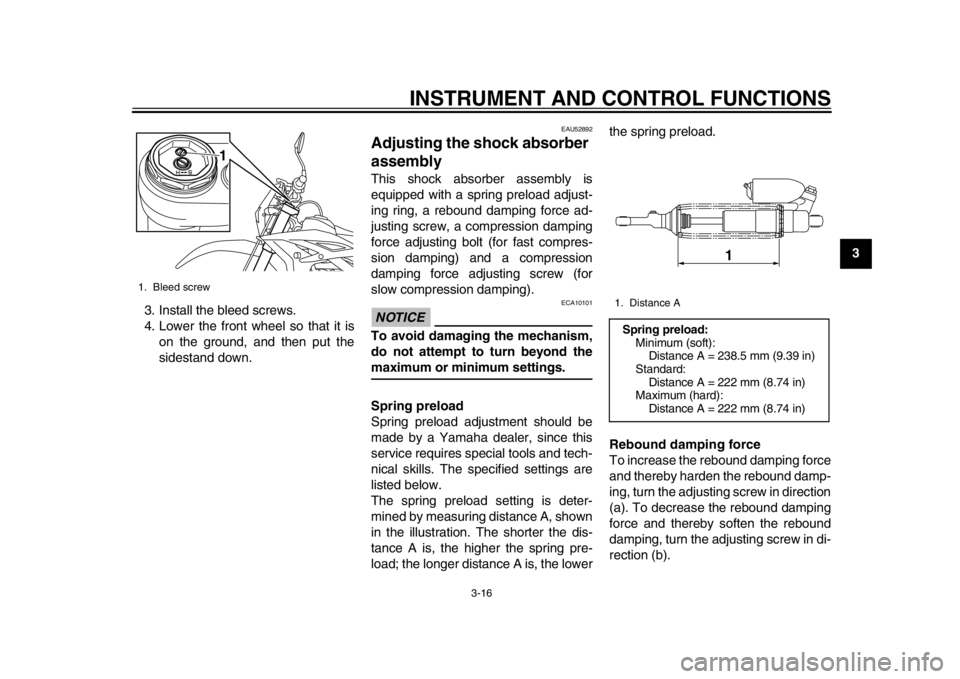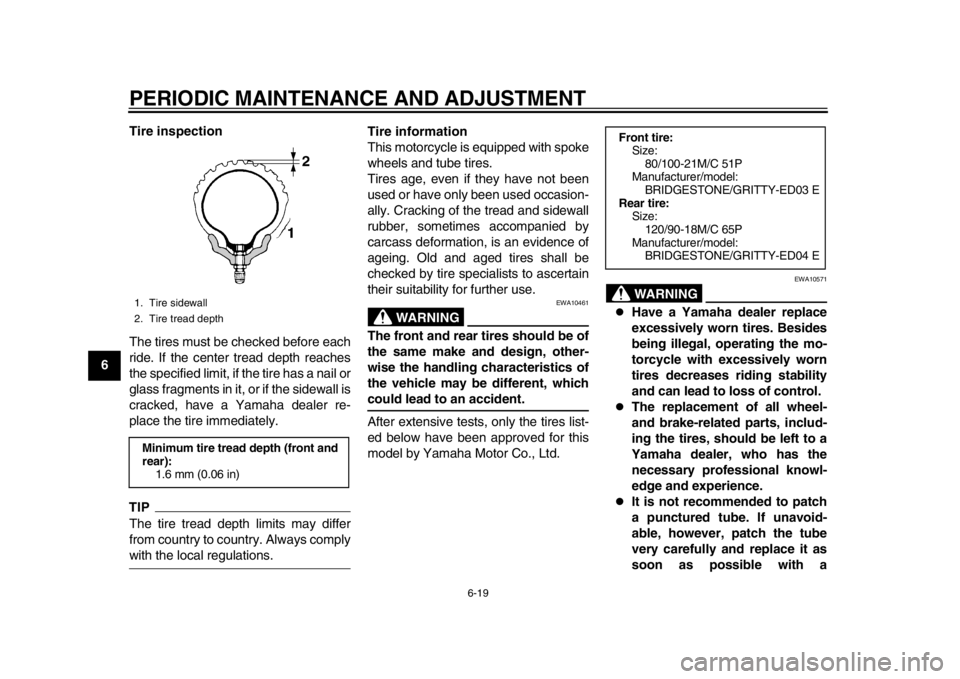wheel YAMAHA WR 450F 2013 Owners Manual
[x] Cancel search | Manufacturer: YAMAHA, Model Year: 2013, Model line: WR 450F, Model: YAMAHA WR 450F 2013Pages: 98, PDF Size: 2.59 MB
Page 6 of 98

TABLE OF CONTENTSSAFETY INFORMATION .................. 1-1
DESCRIPTION .................................. 2-1
Left view .......................................... 2-1
Right view ........................................ 2-2
Controls and instrument s................. 2-3
INSTRUMENT AND CONTROL
FUNCTIONS ....................................... 3-1
Main switch ..................................... 3-1
Indicator lights and warning
lights ............................................ 3-1
Multi-function display ...................... 3-2
Handlebar switches ........................ 3-7
Clutch lever ..................................... 3-8
Shift pedal ...... ............................. .... 3-8
Brake lever ..................................... 3-8
Brake pedal .................................... 3-9
Fuel tank cap .................................. 3-9
Fuel ............................................... 3-10
Fuel tank breather hose ................ 3-11
Catalytic converter ........................ 3-11
Starter knob .................................. 3-12
Kickstarter ...... ............................. .. 3-12
Steering lock ................................. 3-13
Seat .............................................. 3-13
Adjusting the front fork .................. 3-14
Front fork bleeding ........................ 3-15
Adjusting the shock absorber assembly ................................... 3-16
Sidestand ...................................... 3-18 Ignition circuit cut-o
ff system ........ 3-19
FOR YOUR SAFETY –
PRE-OPERATION CHECKS ............. 4-1
OPERATION AND IMPORTANT
RIDING POINTS ................................. 5-1
Starting a cold engine .................... 5-1
Starting a warm engine .................. 5-3
Shifting ........................................... 5-3
Tips for reducing fuel
consumption ............................... 5-4
Engine break-in .............................. 5-4
Parking ........................................... 5-5
PERIODIC MAINTENANCE AND
ADJUSTMENT ................................... 6-1
Owner’s tool kit ............................... 6-2
Periodic maintenance chart for the emission contro l system ....... 6-3
General maintenance and lubrication chart .......................... 6-4
Removing and installing the
panel ........................................... 6-7
Checking the spark plug ................. 6-7
Engine oil and oil filter element ...... 6-8
Coolant ......................................... 6-12
Cleaning the air filter element
and check hose ......................... 6-14
Adjusting the engine idling speed ........................................ 6-17 Checking the throttle grip free
play ............................................ 6-17
Valve clearance ............................ 6-18
Tires .............................................. 6-18
Spoke wheels ............................... 6-20
Adjusting the clutch lever free play ............................................ 6-20
Checking the brake lever free
play ............................................ 6-21
Checking the shift pedal ............... 6-22
Brake light switches ...................... 6-22
Checking the front and rear brake pads ................................. 6-23
Checking the brake fluid level ....... 6-23
Changing the brake fluid ............... 6-24
Drive chain slack ........................... 6-25
Cleaning and lubricating the
drive chain ................................. 6-26
Checking and lubricating the cables ........................................ 6-27
Checking and lubricating the throttle grip and cable ................ 6-27
Checking and lubricating the
brake and clutch levers ............. 6-27
Checking and lubricating the
brake pedal ................................ 6-28
Checking and lubricating the sidestand ................................... 6-28
Lubricating the swingarm pivots ......................................... 6-29
Checking the front fork .................. 6-291DX-9-E1.book 1 ページ 2012年7月31日 火曜日 午前9時31分
Page 7 of 98

TABLE OF CONTENTS
Checking the steering ................... 6-30
Checking the wheel bearings ....... 6-30
Battery .......................................... 6-30
Replacing the fuse ........................ 6-32
Replacing the headlight bulb ........ 6-32
Tail/brake light .............................. 6-34
Replacing a turn signal light bulb ........................................... 6-34
Replacing the license plate light bulb .................................... 6-35
Replacing an auxiliary light
bulb ........................................... 6-35
Supporting the motor cycle ............ 6-36
Front wheel ................................... 6-37
Rear wheel ................................... 6-38
Troubleshooting ............................ 6-40
Troubleshooting charts ................. 6-41
MOTORCYCLE CARE AND
STORAGE .......................................... 7-1
Matte color caution ......................... 7-1
Care ................................................ 7-1
Storage ........................................... 7-3
SPECIFICATIONS ............................. 8-1
CONSUMER INFORMATION ............. 9-1
Identification numbers .................... 9-1
1DX-9-E1.book 2 ページ 2012年7月31日 火曜日 午前9時31分
Page 9 of 98

1-2
1
SAFETY INFORMATION
motorist’s blind spot.
Never maintain a motorcycle without proper knowledge. Con-
tact an authorized motorcycle
dealer to inform you on basic
motorcycle maintenance. Cer-
tain maintenance can only be
carried out by certified staff.
Many accidents involve inexperi-
enced operators.
Make sure that you are qualifiedand that you only lend your mo-
torcycle to other qualified opera-
tors.
Know your skills and limits. Staying within your limits may
help you to avoid an accident.
We recommend that you prac- tice riding your motorcycle until
you have become thoroughly fa-
miliar with the motorcycle and all
of its controls.
Many accidents have been caused
by error of the motorcycle opera-
tor. A typical error made by the op-
erator is veering wide on a turn
due to excessive speed or under-
cornering (insufficient lean angle
for the speed). Always obey the speed limit and
never travel faster than warrant-
ed by road and traffic conditions.
Always signal before turning or changing lanes. Make sure that
other motorists can see you.
Ride cautiously in unfamiliar ar-
eas. You may encounter hidden
obstacles that could cause an ac-
cident.
The posture of the operator is im-
portant for proper control. The op-
erator should keep both hands on
the handlebar and both feet on the
operator footrests during operation
to maintain control of the motorcy-
cle.
Never ride under the influence of
alcohol or other drugs.
Protective Apparel
The majority of fatalities from motorcy-
cle accidents are the result of head in-
juries. The use of a safety helmet is the
single most critical factor in the preven-
tion or reduction of head injuries.
Always wear an approved helmet.
Wear a face shield or goggles.
Wind in your unprotected eyes could contribute to an impairment
of vision that could delay seeing a
hazard.
The use of a jacket, heavy boots,
trousers, gloves, etc., is effective in
preventing or reducing abrasions
or lacerations.
Never wear loose-fitting clothes,
otherwise they could catch on the
control levers, footrests, or wheels
and cause injury or an accident.
Always wear protective clothing
that covers your legs, ankles, and
feet. The engine or exhaust sys-
tem become very hot during or af-
ter operation and can cause burns.
Avoid Carbon Monoxide Poisoning
All engine exhaust contains carbon
monoxide, a deadly gas. Breathing car-
bon monoxide can cause headaches,
dizziness, drowsiness, nausea, confu-
sion, and eventually death.
Carbon Monoxide is a colorless, odor-
less, tasteless gas which may be
present even if you do not see or smell
any engine exhaust. Deadly levels of
carbon monoxide can collect rapidly
and you can quickly be overcome and
1DX-9-E1.book 2 ページ 2012年7月31日 火曜日 午前9時31分
Page 11 of 98

1-4
1
SAFETY INFORMATION
mended by Yamaha, even if sold and
installed by a Yamaha dealer.
Aftermarket Parts, Accessories,
and Modifications
While you may find aftermarket prod-
ucts similar in design and quality to
genuine Yamaha accessories, recog-
nize that some aftermarket accessories
or modifications are not suitable be-
cause of potential safety hazards to you
or others. Installing aftermarket prod-
ucts or having other modifications per-
formed to your vehicle that change any
of the vehicle’s design or operation
characteristics can put you and others
at greater risk of serious injury or death.
You are responsible for injuries related
to changes in the vehicle.
Keep the following guidelines in mind,
as well as those provided under “Load-
ing” when mounting accessories.
Never install accessories that
would impair the performance of
your motorcycle. Carefully inspect
the accessory before using it to
make sure that it does not in any
way reduce ground clearance or
cornering clearance, limit suspen-sion travel, steering travel or con-
trol operation, or obscure lights or
reflectors.
Accessories fitted to the handle-
bar or the front fork area can
create instability due to improper
weight distribution. If accesso-
ries are added to the handlebar
or front fork area, they must be
as lightweight as possible and
should be kept to a minimum.
Bulky or large accessories may seriously affect the stability of
the motorcycle. Wind may at-
tempt to lift the motorcycle, or
the motorcycle may become un-
stable in cross winds.
Certain accessories can dis- place the operator from his or
her normal riding position. This
improper position limits the free-
dom of movement of the opera-
tor and may limit control ability,
therefore, such accessories are
not recommended.
Use caution when adding electri-
cal accessories. If electrical acces-
sories exceed the capacity of the
motorcycle’s electr ical system, an electric failure could result, which
could cause a dangerous loss of
lights or engine power.
Aftermarket Tires and Rims
The tires and rims that came with your
motorcycle were designed to match the
performance capabilities and to provide
the best combination of handling, brak-
ing, and comfort. Other tires, rims, siz-
es, and combinations may not be
appropriate. Refer to page 6-18 for tire
specifications and more information on
replacing your tires.
Transporting the Motorcycle
Be sure to observe following instruc-
tions before transporting the motorcy-
cle in another vehicle.
Remove all loose items from the
motorcycle.
Point the front wheel straight
ahead on the trailer or in the truck
bed, and choke it in a rail to pre-
vent movement.
Shift the transmission in gear (for
models with a manual transmis-
sion).
Secure the motorcycle with
1DX-9-E1.book 4 ページ 2012年7月31日 火曜日 午前9時31分
Page 21 of 98

INSTRUMENT AND CONTROL FUNCTIONS
3-6
234
5
6
7
8
9
ton together again.
TIPThe stopwatch will continue counting
when the vehicle is stopped. To stop
and/or resume counting, repeat steps 3and 4.
Measurement mode (for calibrating
the distance-compensation tripme-
ter’s reading)
The distance-compensation tripmeter
is a feature intended to provide a more
accurate tripmeter reading for enduro
riding. Calibrating this meter in accor-
dance with the distances specified on
the enduro course map will help famil-
iarize the rider with the course. In addi-
tion, calibrating the meter may also be
necessary when using tire, wheel,
chain sprocket sizes, etc. other than
specified. For further information con-
cerning the use of this meter, please
consult your nearby Yamaha dealer.
Calibrate the distance-compensation
tripmeter as follows.
To increase the reading, push the
“SLCT 1” button. To decrease the read-
ing, push the “SLCT 2” button. Pushing and holding either button will increase
or decrease the reading continuously
until the button is released.
TIPCalibrating the reading of the dis-
tance-compensation tripmeter is possi-
ble regardless of the stopwatchoperation.
Resetting the distance-compensa-
tion tripmeter or the distance-com-
pensation tripmeter in combination
with the stopwatchTIPResetting can be made only to the dis-
tance-compensation tripmeter or to the
distance-compensation tripmeter incombination with the stopwatch.
Resetting the distance-compensationtripmeter1. Check that the stopwatch mea-
surement is in operation.
2. Reset the distance-compensation tripmeter to zero by pushing the
“RST” button for at least two sec-
onds. Resetting the distance-compensation
tripmeter in combination with the stop-watch1. Stop the stopwatch.
2. Reset the distance-compensation
tripmeter and the stopwatch to
zero by pushing the “RST” button
for at least two seconds.
1DX-9-E1.book 6 ページ 2012年7月31日 火曜日 午前9時31分
Page 30 of 98

INSTRUMENT AND CONTROL FUNCTIONS
3-15
1
23
4
5
6
7
8
9each fork leg in direction (b).
TIPAlthough the total number of clicks of a
damping force adjusting mechanism
may not exactly match the above spec-
ifications due to small differences in
production, the actual number of clicks
always represents the entire adjusting range. To obtain a precise adjustment,
it would be advisable to check the num-
ber of clicks of each damping force ad-
justing mechanism and to modify the
specifications as necessary.
EAU14793
Front fork bleeding
WARNING
EWA10200
Always bleed both fork legs, other-
wise poor handling and loss of sta-bility may result.
When riding in extremely rough condi-
tions, the air temperature and pressure
in the front fork will rise. This will in-
crease the spring preload and harden
the front suspension. If this occurs,
bleed the front fork as follows.
1. Lift the front wheel off the ground according to the procedure on
page 6-36.TIPWhen bleeding the front fork, there
should be no weight on the front end ofthe vehicle.
2. Remove the bleed screws and al- low all of the air to escape from
each fork leg.
1. Compression damping force adjusting screwCompression damping setting:Minimum (soft):
20 click(s) in direction (b)*
Standard: 14 click(s) in direction (b)*
Maximum (hard): 0 click(s) in direction (b)*
* With the adjusting screw fully turned
in direction (a)
(a)(b)
1
1DX-9-E1.book 15 ページ 2012年7月31日 火曜日 午前9時31分
Page 31 of 98

INSTRUMENT AND CONTROL FUNCTIONS
3-16
234
5
6
7
8
9
3. Install the bleed screws.
4. Lower the front wheel so that it is
on the ground, and then put the
sidestand down.
EAU52892
Adjusting the shock absorber
assembly This shock absorber assembly is
equipped with a spring preload adjust-
ing ring, a rebound damping force ad-
justing screw, a compression damping
force adjusting bolt (for fast compres-
sion damping) and a compression
damping force adjusting screw (for
slow compression damping).NOTICE
ECA10101
To avoid damaging the mechanism,
do not attempt to turn beyond themaximum or minimum settings.
Spring preload
Spring preload adjustment should be
made by a Yamaha dealer, since this
service requires special tools and tech-
nical skills. The specified settings are
listed below.
The spring preload setting is deter-
mined by measuring distance A, shown
in the illustration. The shorter the dis-
tance A is, the higher the spring pre-
load; the longer distance A is, the lower the spring preload.
Rebound damping force
To increase the rebound damping force
and thereby harden the rebound damp-
ing, turn the adjusting screw in direction
(a). To decrease the rebound damping
force and thereby soften the rebound
damping, turn the adjusting screw in di-
rection (b).
1. Bleed screw
1
1. Distance ASpring preload:
Minimum (soft):
Distance A = 238.5 mm (9.39 in)
Standard: Distance A = 222 mm (8.74 in)
Maximum (hard): Distance A = 222 mm (8.74 in)
1
1DX-9-E1.book 16 ページ 2012年7月31日 火曜日 午前9時31分
Page 37 of 98

FOR YOUR SAFETY – PRE-OPERATION CHECKS
4-2
2
345
6
7
8
9
Rear brake Check operation.
If soft or spongy, have Yamaha dealer bleed hydraulic system.
Check brake pads for wear.
Replace if necessary.
Check fluid level in reservoir.
If necessary, add specified brak
e fluid to specified level.
Check hydraulic system for leakage. 6-23
Clutch Check operation.
Lubricate cable if necessary.
Check lever free play.
Adjust if necessary. 6-20
Throttle grip Make sure that operation is smooth.
Check throttle grip free play.
If necessary, have Yamaha dealer adjust
throttle grip free play and lubricate
cable and grip housing. 6-17, 6-27
Control cables Make sure that operation is smooth.
Lubricate if necessary. 6-27
Drive chain Check chain slack.
Adjust if necessary.
Check chain condition.
Lubricate if necessary. 6-25, 6-26
Wheels and tires Check for damage.
Check tire condition and tread depth.
Check air pressure.
Correct if necessary. 6-18, 6-20
Shift pedal Make sure that operation is smooth.
Correct if necessary. 6-22
Brake pedal Make sure that operation is smooth.
Lubricate pedal pivoting point if necessary. 6-28
Brake and clutch levers Make sure that operation is smooth.
Lubricate lever pivoting
points if necessary. 6-27
Sidestand Make sure that operation is smooth.
Lubricate pivot if necessary. 6-28
ITEM CHECKS PAGE
1DX-9-E1.book 2 ページ 2012年7月31日 火曜日 午前9時31分
Page 47 of 98

PERIODIC MAINTENANCE AND ADJUSTMENT
6-4
2
3
4
567
8
9
EAU52581
General maintenance and lubrication chart NO. ITEM CHECKS AND MAINTENANCE JOBS INITIAL
ODOMETER
READINGS
ANNUAL CHECK
1000 km
(600 mi) or 1 month 3000 km
(1800 mi) or 3
months 5000 km
(3000 mi) or 6
months
1* Air filter element Clean.
Replace if damaged.
2 Clutch Check operation.
Adjust or replace cable.
3* Front brake Check operation, fluid level
and vehicle for fluid leakage.
Replace brake pads. Whenever worn to the limit
4* Rear brake Check operation, fluid level
and vehicle for fluid leakage.
Replace brake pads. Whenever worn to the limit
5* Brake hoses Check for cracks or damage.
Check for correct routing and clamping.
Replace. Every 20000 km (12000 mi) or every two years
6* Brake fluid Replace. Every 2 years
7* Wheels Check runout, spoke tightness and for damage.
Tighten spokes if necessary.
8* Tires Check tread depth and for damage.
Replace if necessary.
Check air pressure.
Correct if necessary.
9* Wheel bearings Check bearing for looseness or damage.
10 * Swingarm Check operation and for excessive play.
Lubricate with lithium-soap-based grease.
11 Drive chain Check chain slack, alignment and condition.
Adjust and lubricate chain with a special O-ring chain
lubricant thoroughly. Every ride
1DX-9-E1.book 4 ページ 2012年7月31日 火曜日 午前9時31分
Page 62 of 98

PERIODIC MAINTENANCE AND ADJUSTMENT
6-19
1
2
3
4
56
7
8
9Tire inspection
The tires must be checked before each
ride. If the center tread depth reaches
the specified limit, if the tire has a nail or
glass fragments in it, or if the sidewall is
cracked, have a Yamaha dealer re-
place the tire immediately.
TIPThe tire tread depth limits may differ
from country to country. Always complywith the local regulations. Tire information
This motorcycle is equipped with spoke
wheels and tube tires.
Tires age, even if they have not been
used or have only been used occasion-
ally. Cracking of the tread and sidewall
rubber, sometimes accompanied by
carcass deformation, is an evidence of
ageing. Old and aged tires shall be
checked by tire specialists to ascertain
their suitability for further use.
WARNING
EWA10461
The front and rear tires should be of
the same make and design, other-
wise the handling characteristics of
the vehicle may be different, whichcould lead to an accident.
After extensive tests, only the tires list-
ed below have been approved for this
model by Yamaha Motor Co., Ltd.
WARNING
EWA10571
Have a Yamaha dealer replace
excessively worn tires. Besides
being illegal, operating the mo-
torcycle with excessively worn
tires decreases riding stability
and can lead to loss of control.
The replacement of all wheel-
and brake-related parts, includ-
ing the tires, should be left to a
Yamaha dealer, who has the
necessary professional knowl-
edge and experience.
It is not recommended to patch
a punctured tube. If unavoid-
able, however, patch the tube
very carefully and replace it as
soon as possible with a
1. Tire sidewall
2. Tire tread depthMinimum tire tread depth (front and
rear):
1.6 mm (0.06 in)
Front tire: Size:80/100-21M/C 51P
Manufacturer/model:
BRIDGESTONE/GRITTY-ED03 E
Rear tire: Size:
120/90-18M/C 65P
Manufacturer/model: BRIDGESTONE/GRITTY-ED04 E
1DX-9-E1.book 19 ページ 2012年7月31日 火曜日 午前9時31分